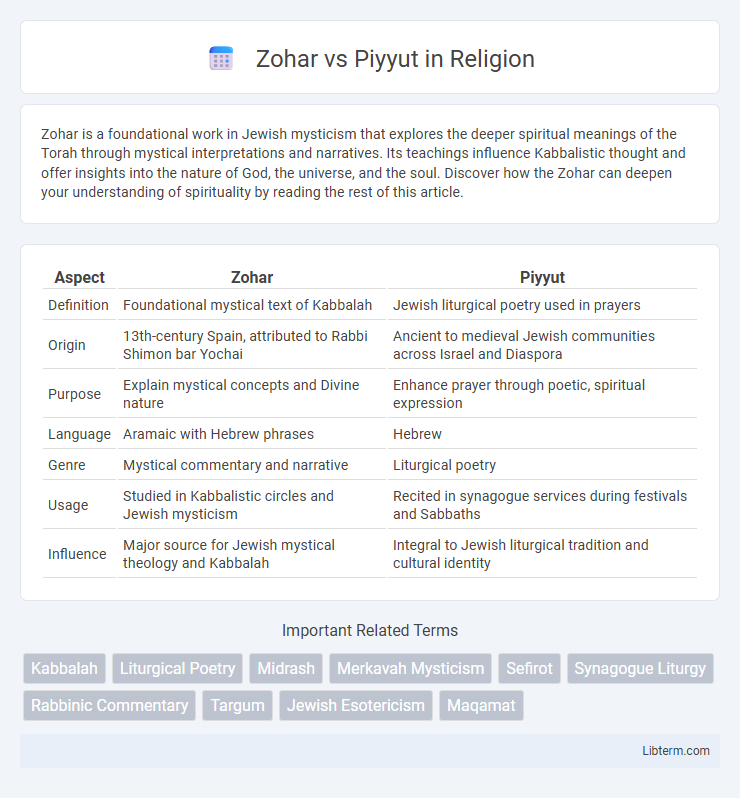Zohar is a foundational work in Jewish mysticism that explores the deeper spiritual meanings of the Torah through mystical interpretations and narratives. Its teachings influence Kabbalistic thought and offer insights into the nature of God, the universe, and the soul. Discover how the Zohar can deepen your understanding of spirituality by reading the rest of this article.
Table of Comparison
| Aspect | Zohar | Piyyut |
|---|---|---|
| Definition | Foundational mystical text of Kabbalah | Jewish liturgical poetry used in prayers |
| Origin | 13th-century Spain, attributed to Rabbi Shimon bar Yochai | Ancient to medieval Jewish communities across Israel and Diaspora |
| Purpose | Explain mystical concepts and Divine nature | Enhance prayer through poetic, spiritual expression |
| Language | Aramaic with Hebrew phrases | Hebrew |
| Genre | Mystical commentary and narrative | Liturgical poetry |
| Usage | Studied in Kabbalistic circles and Jewish mysticism | Recited in synagogue services during festivals and Sabbaths |
| Influence | Major source for Jewish mystical theology and Kabbalah | Integral to Jewish liturgical tradition and cultural identity |
Introduction to Zohar and Piyyut
The Zohar, a foundational work of Jewish mysticism authored in the late 13th century, explores esoteric interpretations of the Torah through mystical commentary. Piyyut, by contrast, comprises liturgical poems composed from late Antiquity through the Middle Ages, enriching Jewish prayer services with thematic and poetic expressions. Both the Zohar and piyyutim serve vital roles in Jewish spiritual life, with the Zohar emphasizing mystical insight and piyyutim enhancing communal worship and liturgical tradition.
Historical Background of Zohar
The Zohar, a foundational work of Jewish mysticism, emerged in 13th-century Spain, attributed to the sage Rabbi Shimon bar Yochai and compiled primarily by Moses de Leon. It offers an esoteric interpretation of the Torah, revealing hidden spiritual dimensions and Kabbalistic teachings. This mystical text differs significantly from Piyyut, which consists of liturgical poems used in synagogue services with roots in early medieval Jewish communities.
Origins and Development of Piyyut
Piyyut originated in late antiquity within Jewish liturgical traditions, evolving from Hebrew poetic compositions crafted to enhance synagogue services through structured verses. This genre flourished primarily in the Land of Israel and Babylonia between the 5th and 8th centuries, integrating biblical allusions and complex acrostics that underscored its ritual significance. Unlike the mystical and esoteric nature of the Zohar, piyyutim reflect a more formalized poetic development aimed at communal worship and religious expression in early Jewish history.
Core Themes in the Zohar
The Zohar centers on mystical interpretations of the Torah, emphasizing themes such as divine emanations (Sefirot), the nature of the soul, and the cosmic struggle between good and evil. It explores the hidden spiritual dimensions of scripture through allegory and symbolic language, seeking deeper understanding of God's interaction with the world. Unlike Piyyut, which focuses on liturgical poetry and devotional expression, the Zohar prioritizes esoteric wisdom and the metaphysical essence of Jewish spirituality.
Key Motifs in Piyyut Poetry
Piyyut poetry centers on key motifs such as divine kingship, exile, redemption, and communal prayer, reflecting the liturgical and historical context of Jewish worship. Its intricate language incorporates biblical allusions and acrostics, emphasizing themes of praise, supplication, and religious identity. Unlike the mystical and esoteric symbolism found in the Zohar, piyyut uses accessible poetic forms to evoke emotional and spiritual responses during synagogue services.
Linguistic Features: Zohar vs. Piyyut
The Zohar employs Aramaic with a complex, mystical lexicon, featuring metaphorical and symbolic language that emphasizes esoteric concepts, while Piyyut utilizes Hebrew, incorporating poetic structures such as parallelism, acrostics, and rhyme to enhance liturgical and emotional expression. Zohar's syntax often includes paratactic clauses and cryptic phrasing, aiming to conceal deeper spiritual meanings, whereas Piyyut follows more formal rhythmic patterns designed for congregational chanting and memorability. The linguistic divergence highlights the Zohar's role in mystical theology contrasted with Piyyut's function in communal worship through accessible and aesthetically crafted Hebrew poetry.
Liturgical and Mystical Functions
The Zohar primarily serves a mystical function in Jewish tradition, offering esoteric interpretations of the Torah and bridging spiritual concepts within Kabbalistic thought. Piyyut, on the other hand, embodies a liturgical role, enriching Jewish prayer services through poetic compositions that enhance communal worship and emotional expression. While the Zohar deepens individual and collective mystical understanding, piyyut shapes the flow and fervor of ritual observance in synagogues.
Influence on Jewish Worship and Thought
The Zohar profoundly shapes Jewish mysticism, embedding Kabbalistic concepts into prayer and spiritual contemplation, thus enhancing the esoteric dimensions of worship. Piyyut, composed of liturgical poems, enriches synagogue services by introducing poetic expressions and thematic depth, fostering communal engagement and emotional resonance. Both texts influence Jewish thought by intertwining tradition with spirituality, yet the Zohar emphasizes mystical introspection while Piyyut focuses on liturgical creativity and public devotion.
Comparative Analysis: Spiritual Impact
The Zohar and Piyyut serve distinct spiritual roles within Jewish tradition, with the Zohar offering deep mystical insights and esoteric wisdom foundational to Kabbalistic study. Piyyut, comprised of liturgical poems, enhances communal worship by fostering emotional connection and collective spiritual elevation during prayer. The Zohar's influence is more contemplative and transformative on an individual level, while Piyyut impacts the spiritual atmosphere of the congregation, creating a shared experiential devotion.
Modern Relevance and Scholarship
The Zohar and Piyyut maintain distinct but complementary roles in contemporary Jewish scholarship and practice, with the Zohar serving as a central mystical text foundational to Kabbalistic studies, influencing modern spirituality and Jewish thought. Piyyut continues to enrich liturgical traditions, inspiring contemporary poets and enhancing communal prayer experiences through its poetic and musical innovations. Current academic research explores their interrelations, historical contexts, and ongoing impact on cultural identity and religious expression within diverse Jewish communities.
Zohar Infographic

 libterm.com
libterm.com